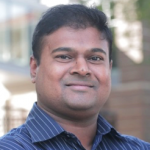 Microballistics: From Dynamic Testing of Emerging Materials to Creation of Heterogeneous Nanostructures in Metals
Microballistics: From Dynamic Testing of Emerging Materials to Creation of Heterogeneous Nanostructures in Metals
Speaker: Dr. Ramathasan Thevamaran, Assistant Professor, Department of Mechanical Engineering University of Wisconsin-Madison
When: April 6, 9:30 AM | Location: CEME 1203 (6250 Applied Science Lane)
Abstract:
The advanced laser-induced projectile impact testing (LIPIT) technique enables supersonic impact of selectively launched microprojectiles onto targets with simultaneous ultra-high-speed imaging of projectile trajectory. I will present two distinct applications of LIPIT: (i) impact testing of nanofibrous materials for protective applications and (ii) impact-induced nanostructures in metals to attain synergistic improvement of strength and toughness. Nanofibrous materials offer an opportunity to synergistically exploit intrinsic nanofiber properties and inter-fiber interactions for dynamic performance enhancement that is critical for lightweight armor and spacecraft. We show a synergistic performance improvement with failure retardation in carbon nanotube (CNT) mats by augmenting the weak van der Waal interactions with stronger and reconfigurable interfacial hydrogen bonds formed by introducing aramid nanofiber (ANF) links between CNTs. Under supersonic microprojectile impacts, strengthened dynamic interactions in ANF-CNT mats enhance their specific energy absorption up to a hundred percent—outperforming other nanomaterials and widely used bulk Kevlar fiber-based protective materials. Impact and shock compression, on the other hand, have long been used to modify the mechanical properties of metals, for example, in shot peening and laser shock peening processes. We use LIPIT to launch individual near-defect-free single-crystal Ag microcubes at high velocities (~400 m/s) and impact onto a rigid target. Dynamically deformed Ag microcubes investigated through transmission Kikuchi diffraction (TKD) show a distinctive gradient-nano-grained structure formation when impacted along the [100] direction. Stress-strain responses measured through in situ SEM micro-compression of pillars FIB-milled from these impacted cubes show high hardening rate, high yield stress, and large compressive toughness—demonstrating promising pathways to developing ultra-strong metals that are also tough enough to resist failure.
Biography:
Prof. Ramathasan Thevamaran received his B.Sc.Eng.(Hons.) (2008) in Civil Engineering from the University of Peradeniya, Sri Lanka, and his M.S. (2010) and Ph.D. (2015) in Mechanical Engineering from the California Institute of Technology, CA. Prior to joining the University of Wisconsin-Madison in 2017, he was a Postdoctoral Research Associate at the Department of Materials Science and Nanoengineering of Rice University, TX. His research focuses on (i) developing a fundamental understanding of the process-structure-property-function relations in structured materials, and (ii) creating innovative structured materials with superior specific properties and novel functionalities for extreme engineering applications. His research has been published in several prestigious journals including, Science, Nature, Nature Communications, Nano Letters, ACS Nano, Acta Materialia, Extreme Mechanics Letters, and Materials Today, and has been featured in numerous popular science articles, television, and public radio. He is the recipient of 2022 Early Career Faculty Award from NASA, 2022 Innovation Award from the Wisconsin Alumni Research Foundation, and 2021 Ferdinand P. Beer and E. Russel Johnston, Jr. Outstanding New Mechanics Educator Award from the American Society for Engineering Education.